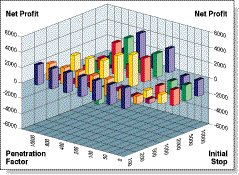MONEY MANAGEMENT
Barrier Stops And Trendlines
by Jeffrey Owen Katz, Ph.D., and Donna L. McCormick
Last time, Katz and McCormick measured the performance of using this strategy as an exit rule. This time, we examine the effect of eliminating entries that would have been taken in instances where the trendline stop was farther than $1,250 away from the entry price.
In recent articles, we experimented with exits to determine whether simple exit strategies can improve the performance of a system with essentially random trade entries. We have explored a strategy that involved a profit target exit, a stop-loss exit and a time-based exit, and then examined the behavior of trailing stops. Throughout these experiments, we used a standardized random entry system in which a random number generator provided us with the entries into positions from which we could exit. In all instances, we found that exit methods could significantly improve a system or ruin it, depending on whether the strategies were correctly chosen and/or applied.
For example, stop-losses and profit targets of the wrong sizes, or incorrect parameters for trailing stops, can make a trading system perform significantly worse than it would otherwise. Finally, we found that while there is some interaction between the two, overall, the behavior of exits seems to be relatively unaffected by the entry methods employed. Last time, we continued our study of exit strategies by exploring a particular kind of barrier stop -- specifically, one based on trendlines. A barrier stop, like an ordinary stop, gets you out of a trade when the market moves against you. A barrier exit is taken when the market touches or penetrates some barrier; in our experiment, that barrier was based on trendlines.
Because such a barrier stop may be repeatedly adjusted as the trade progresses, it can lock in some of the paper profits that may accrue if the market moves in the desired direction. To implement the barrier stops, at each entry we used an algorithmic trendline detector that determined those trendlines lying closest to the entry price without intersecting it. When a trendline was detected, we extended it forward to place our stop. The exact placement of the stop in long positions was the highest of either the trendline or the entry price minus a certain dollar amount of movement as an initial stop; for short trades, our stop was placed at the lowest of the downsloping trendline or the stop level. In this way, our stop was never more than a specified amount away from our entry point, but we had the option of bringing it in tighter if a closer trendline was available. A separate money management stop was not required, since the trendline stop served that purpose. The results suggested that trendline-based barrier exits can greatly improve the overall performance of a trading system: Net profits were boosted and drawdowns were reduced. In some cases, this type of barrier exit produced better results than simple trailing stops did.

FIGURE 1: NET PROFIT. The yellow columns represent the $1,000 initial stop. The peak value is $4,150.
The experiment yielded ambiguous results. The number of trades left after excluding those not close to the trendline were too few to give meaningful results.